Well ..."OH, NUTS" can mean a lot of things.
Right now it means the descent of nuts from trees into our lawns and gardens,
which might mean "OH, OUCH!"... (or worse!),
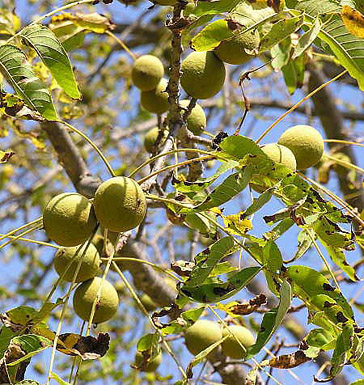
and also into our markets, which might mean
"OH BOY!"
... and ...
"NUTCRACKERS!"
"NUTS", of course, are stories within themselves.
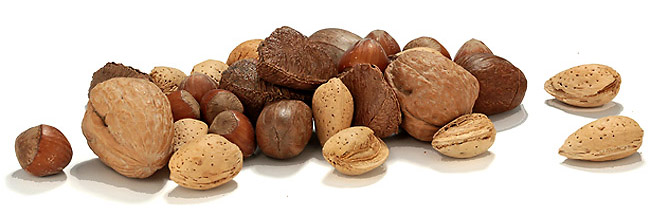
We have long been told the multiple health benefits of nuts -
from weight loss aids (according to Dr. Axe)
to heart health, blood sugar control, even heightened brain function!
And we have apparently been trying to get to this 'miracle food' since prehistoric days -
first just smashing it with a handy rock.
Mankind finally received assistance from plier-type "tools" in the 3rd to 4th century B.C.
Early Romans even honored nuts with exceptionally "decorative" nutcrackers.
The plier form of these tools remained much the same during the medieval era.
Below are 13th century interesting iron nutcracker fragments from the British Museum.
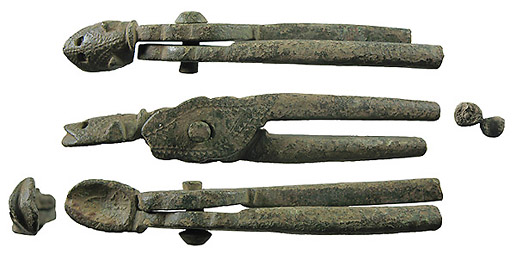
However, during the 15th and 16th century came
the most delightful carved wooden nutcrackers -
popular in Germany and provincial areas of England and France.
Many took the form of small figurines, and were given as keepsakes.
household protectors (being said to "bear their teeth to malevolent intruders"),
and even cherished as "love tokens".
These oft amusing tools were made first in plier and lever forms.
And, in the 17th century, the "screw form" nutcracker was introduced,
first in wood (particularly boxwood), then in metals,
enabling a gentler pressure on the nut shell, thus kinder to both nut - and hands.
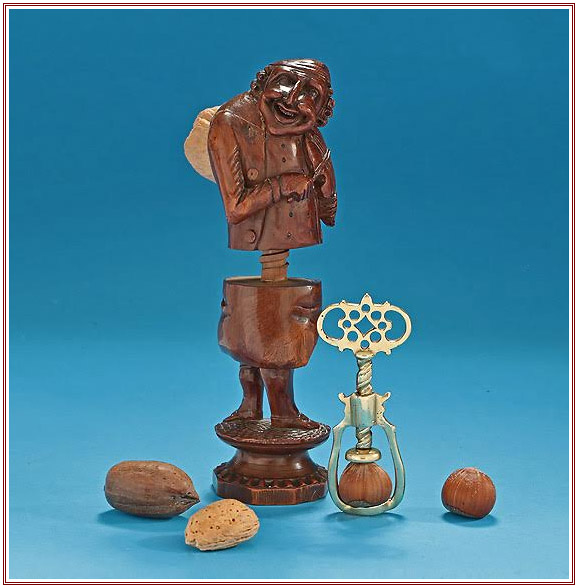
Carved Figural Boxwood Screw-Form Nutcracker
First Half 19th Century, Continental
17th/18th Century Diminutive Brass Thumb-Screw Nutcracker
The oval thumb piece above a threaded screw with disk base
And then there is
... “NUTMEG” ...
a small nut with even more attributes!
And its history is ancient, lusty - and bloody.
Over this small nut, wars have been fought, vast fortunes made, and excessive lives lost.
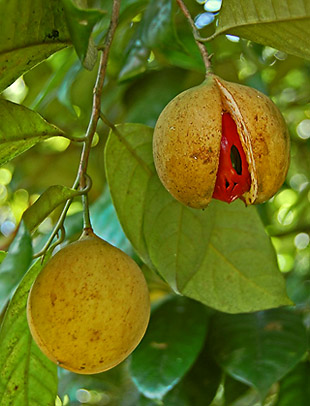
This seed of an evergreen tree is originally
native only to Indonesia’s ‘Spice Islands' of Banda.
Early Arabs had long prized the spice for all manner of digestive and skin issues.
Likewise, Hindus used nutmeg for digestion, headaches,
cold fevers, intestinal weakness, nerve fevers and bad breath.
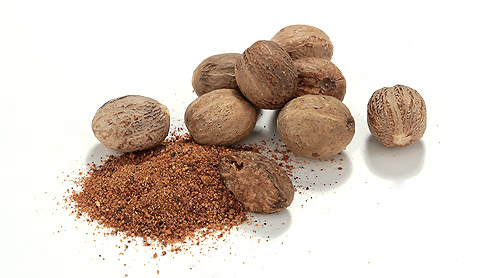
Arab traders introduced nutmeg to Venetians traders,
who took the prized spice back to the Europeans
who used nutmeg for the same medicinal properties,
additionally believing it could ward off the 'dreaded plague'.
As well, European aristocrats prized nutmeg for its abilities
to mask the sour taste of aging food - often kept far too long in springhouses.
European passions made this spice quickly become very sought after -
as well as very expensive.
It also quickly became the center of some very brutal politics.
16th century Portuguese traders controlled not only the Chinese porcelains trade,
but the lucrative spice trade. In 1511, they discovered
and began importing from Indonesia's tiny nutmeg-, mace-, and clove-producing
Banda Islands.
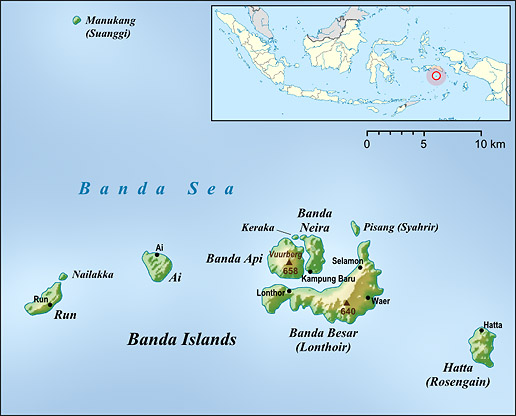
When, in the early 1600s, the Dutch gained dominance of the seas
(and with it, ceramics and spices),
they also took possession the Banda Islands and its spices.
To secure their trade monopoly on this lucrative nut,
Dutch leaders dealt ruthlessly with both people and lands.
They destroyed all the nutmeg trees on the islands
except those on Dutch-controlled plantations,
as well as the majority of the native people.
They even bathed the seeds in lime so they would not germinate elsewhere.
But the story does not end there.
The British eventually founded nutmeg plantations in Grenada and Zanzibar,
rivaling the Dutch 'stranglehold' on nutmeg trade.
However the Dutch, wishing to retain their dominance,
persuaded the British to trade their last nutmeg-producing island
... and some sugar ...
for Manhattan! (1674)
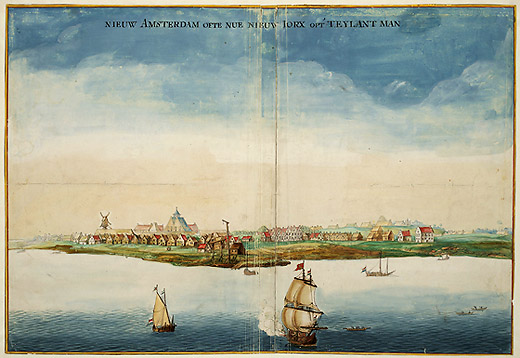
(New Amsterdam of New York, c1674)
* Such was the demand for control of trade centering around this tiny nut! *
And during that same time (c1674), a small silver box carrying nutmeg
became an essential part of the British gentleman's dress.
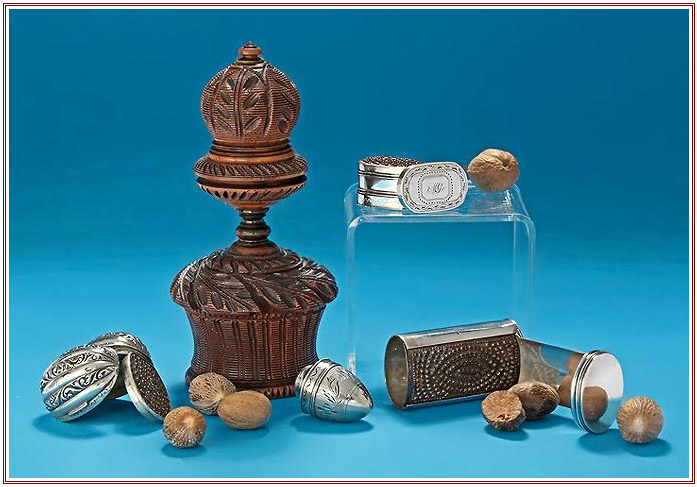
Carried for its fine flavor :
Even Starbucks would not be without it!
For better health :
digestive; pain reliever; anti-inflammatory; detoxification;
improves brain pathways;
antibacterial (it’s in mouthwashes!)
aid in insomnia; skin benefits!
For magical spells !
a whole nutmeg seed carried to bring luck;
one could bring luck to games of chance;
or encourage favorable decisions in legal matters;
a nutmeg in the pocket could ensure good luck while traveling.
And Love !!
a Creole legend suggests sprinkling nutmeg into a woman's shoe at midnight
will encourage her passionate love ;
or (for more love) try sharing a beverage flavored with nutmeg.
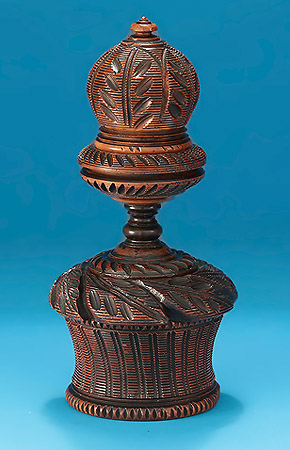
Coquilla Nut & Lignum Vitae Table Nutmeg Grater in 3 sections
England, Late 18th / Early 19th Century,
The acorn top of coquilla nut, the balance of lignum vitae
The above is a large "table" nutmeg grater.
So do take warning : too much can also complicate your bodily processes -
even cause hallucinations if used in excess.
It is a potent and aromatic spice, meant to be used in small quantities -
and far, far better when freshly grated!
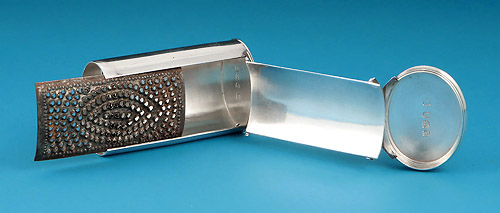
George III Silver Tubular Nutmeg Grater
Thomas Wilkes Barker, London, 1802
With removable blue steel grater & adequate space for several nutmegs
And Two 'FOOTNOTES' :
In 1809 the English returned to Indonesia and seized the Banda Islands by force.
In 1817, they returned the islands to the Dutch,
but not before transplanting hundreds of nutmeg seedlings
to plantations in India, Ceylon and Singapore
On September 24, 2018, Portuguese archeologists released a video
depicting a 400-year-old shipwreck off the coast of Portugal,
calling it the "discovery of a decade".
Sunk between 1575 and 1625, the height of Portugal's spice trade,
spices, ceramics and cannons engraved with Portugal's coat of arms all lie around the wreck.
|